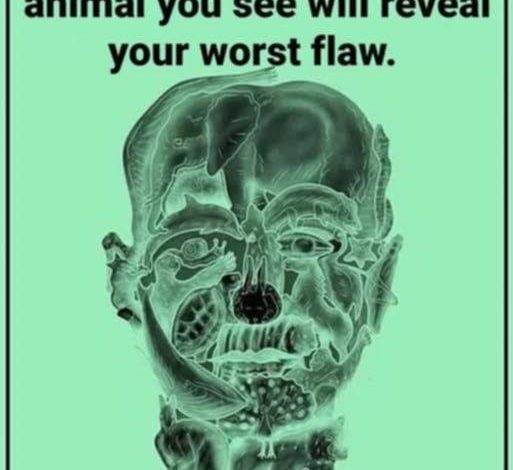
This visual test reveals your worst flaw based on the first animal you see
A striking optical illusion has been circulating across social media, igniting spirited debates, lighthearted banter, and even moments of quiet self-reflection. At first glance, the image appears to be nothing more than a sketch of a human face. But look closer, and you’ll notice that the lines conceal an array of animals, each carefully hidden within the design. The challenge is simple: glance at the picture quickly, identify the very first animal you see, and then read what it supposedly reveals about your biggest personal flaw.
Part of the charm lies in the simplicity—no lengthy questionnaires or deep analysis, just an instant gut reaction. And while no scientific research backs up the claims, these personality-style illusions have a knack for feeling oddly accurate, sparking reactions like, “Wow… that’s so me,” or “Absolutely not!” Whether shared among friends in group chats, reposted on Instagram stories, or used as a playful party game, this test is reviving interest in the quirky world of visual perception challenges and pseudo-psychology.
The concept is straightforward. Viewers are told not to overthink it—just let their eyes land naturally on the image and note which animal stands out first. That initial recognition is said to reveal a dominant trait in your personality, framed here as your “worst flaw.” From stubbornness to mood swings, each animal comes with a short, memorable description that feels personal enough to stick in your mind long after you’ve scrolled past.
The hidden animals vary depending on the version of the image, but here are some of the more common interpretations. Spot an elephant? That supposedly means stubbornness—you hold your ground and resist change, even when compromise might help. See an iguana? You might be emotionally aloof, keeping your distance even from people who care. A pig could indicate indulgence, a love of life’s comforts that sometimes tips into excess. Cricket? That’s linked to anxiety and overthinking. A horse is tied to pride and independence, while a dolphin suggests impulsiveness—acting on instinct for better or worse. Other animals offer different readings: bears are rigid, foxes are avoidance-driven, rabbits carry quiet insecurity, toucans seek the spotlight, turtles are overly cautious, and snakes, well, they hint at strategic manipulation.
More whimsical entries include the kangaroo, for inconsistency and restlessness; the peacock, for vanity; the whale, for emotional isolation; the duck, for unpredictable mood swings; and the starfish, for escapism. Some, like the snail, reflect resistance to change, while others, such as the gorilla, suggest dominance that can cross into control. Each description is written in a way that makes it easy to laugh about—or quietly admit to yourself that maybe there’s a grain of truth.
So why do tests like this go viral again and again? For one, they’re quick and easy—people can participate in seconds without committing to long, detailed personality surveys. They also walk the fine line between vague and specific, offering enough detail to feel tailored while staying general enough to apply to many. And because they’re so shareable, they thrive in the current social media environment, where posts that spark conversations—whether in the comments or in private messages—are the ones that spread fastest.
Of course, no single image can truly capture the complexity of human personality. Who you are is shaped by a lifetime of experiences, habits, and values, not a fleeting moment of visual perception. But that’s not the point. The appeal lies in the fun of it, the momentary pause in a busy day to see what your subconscious might “choose” first. In a way, it’s less about uncovering deep truths and more about connecting—with friends, with strangers online, or even with parts of yourself you don’t often think about.
At their best, these tests can spark curiosity and reflection. You might dismiss your result as silly, or you might find yourself pondering whether you really do avoid confrontation or cling too tightly to routine. And even if you walk away with nothing more than a laugh, it’s still a shared moment of entertainment—something that feels increasingly valuable in a world that’s often serious and divided.
The next time one of these “first animal you see” illusions crosses your feed, it might be worth taking a moment to play along. Not because it will define you, but because it’s a reminder that even a simple picture can start conversations, reveal small truths, or just make you smile. And in the end, that lighthearted connection is worth more than any label a hidden elephant, dolphin, or fox could ever give you.




